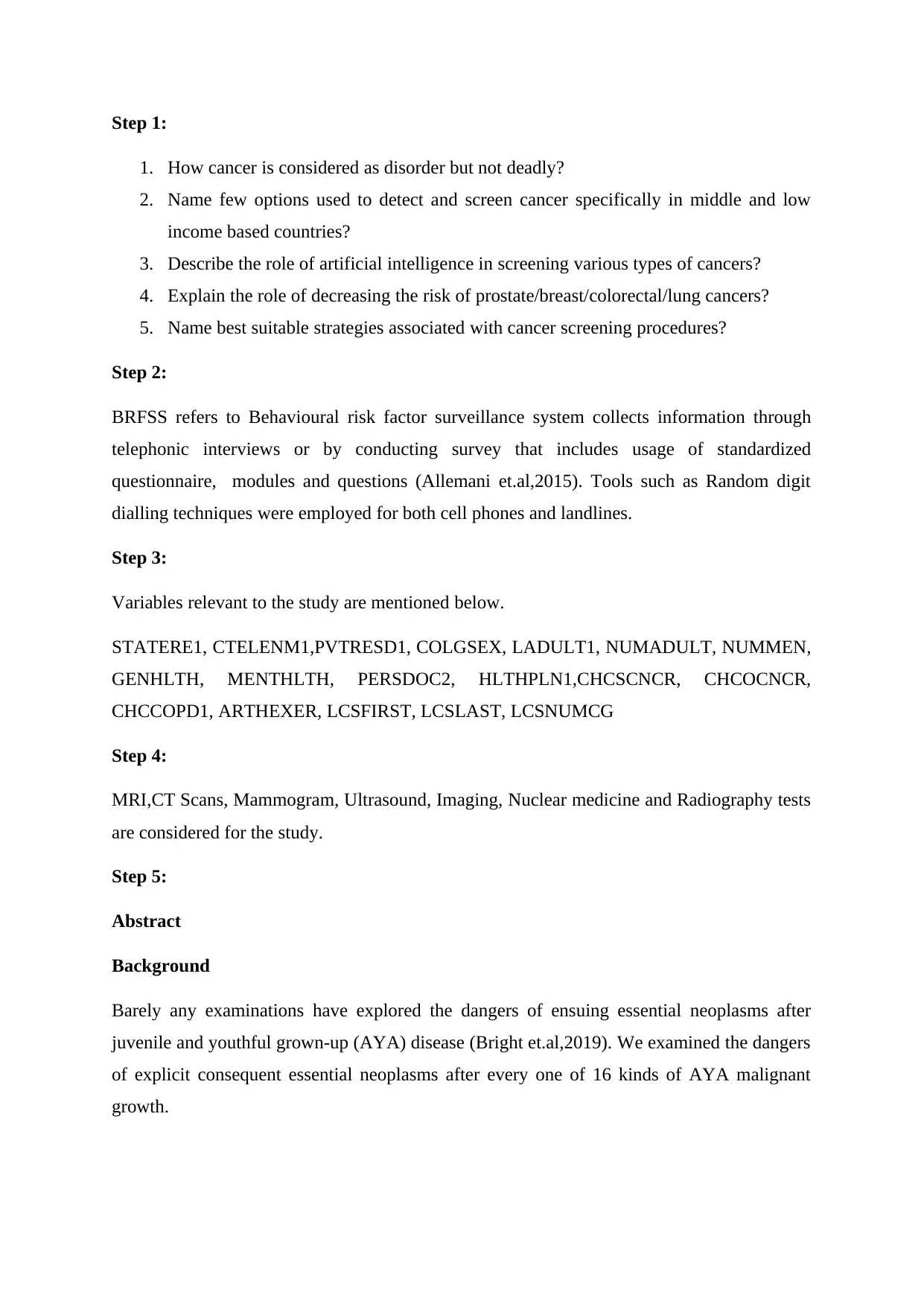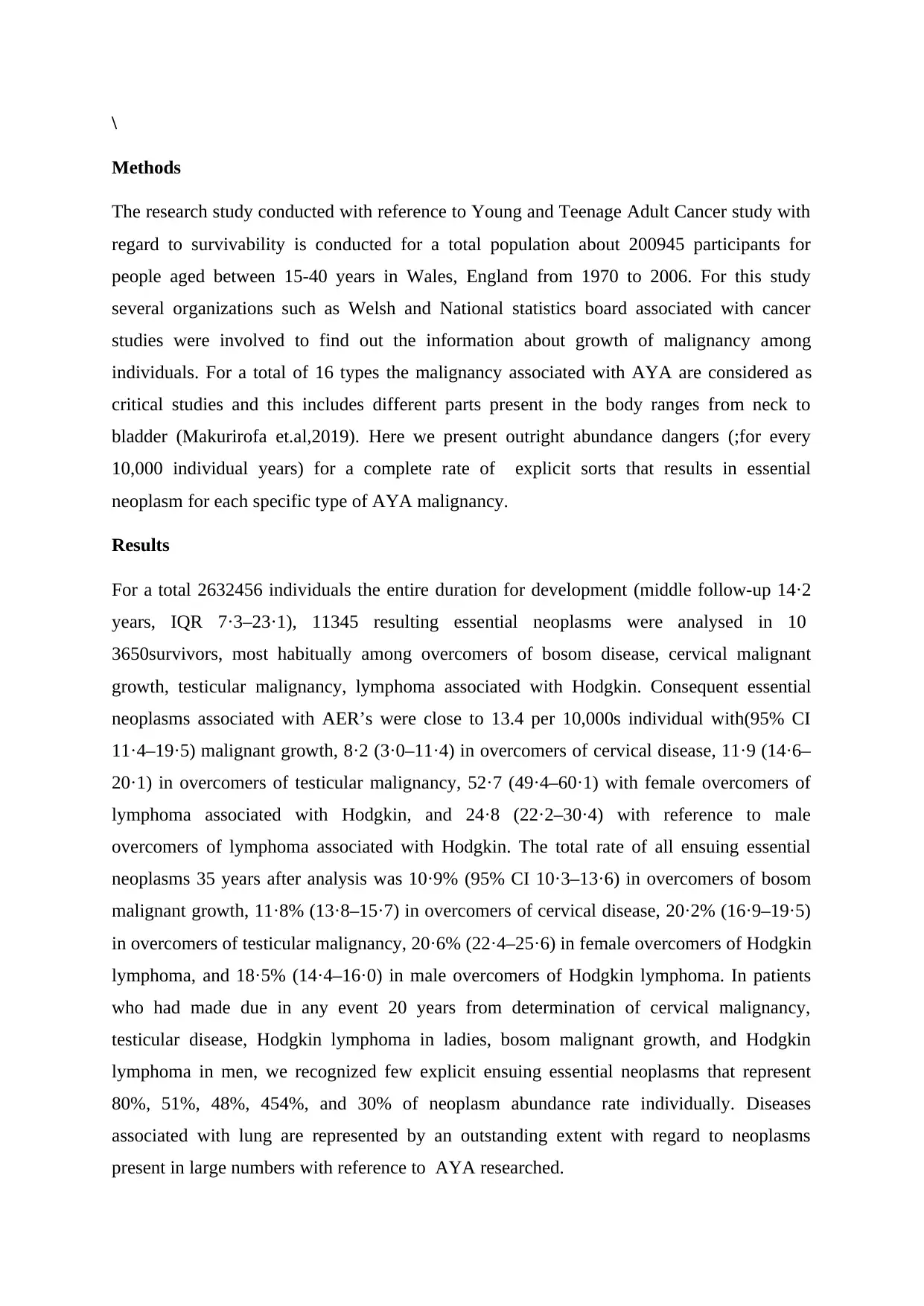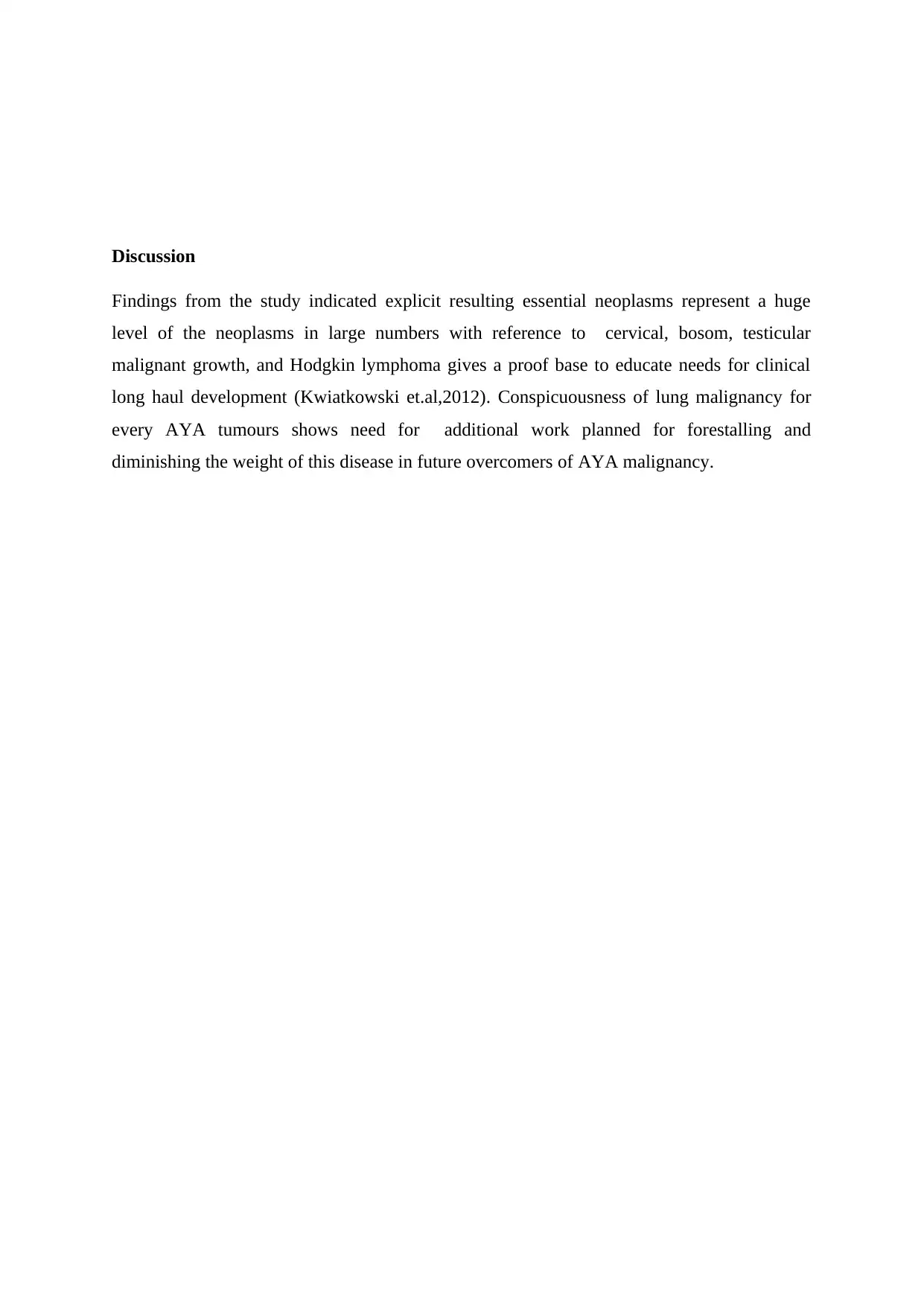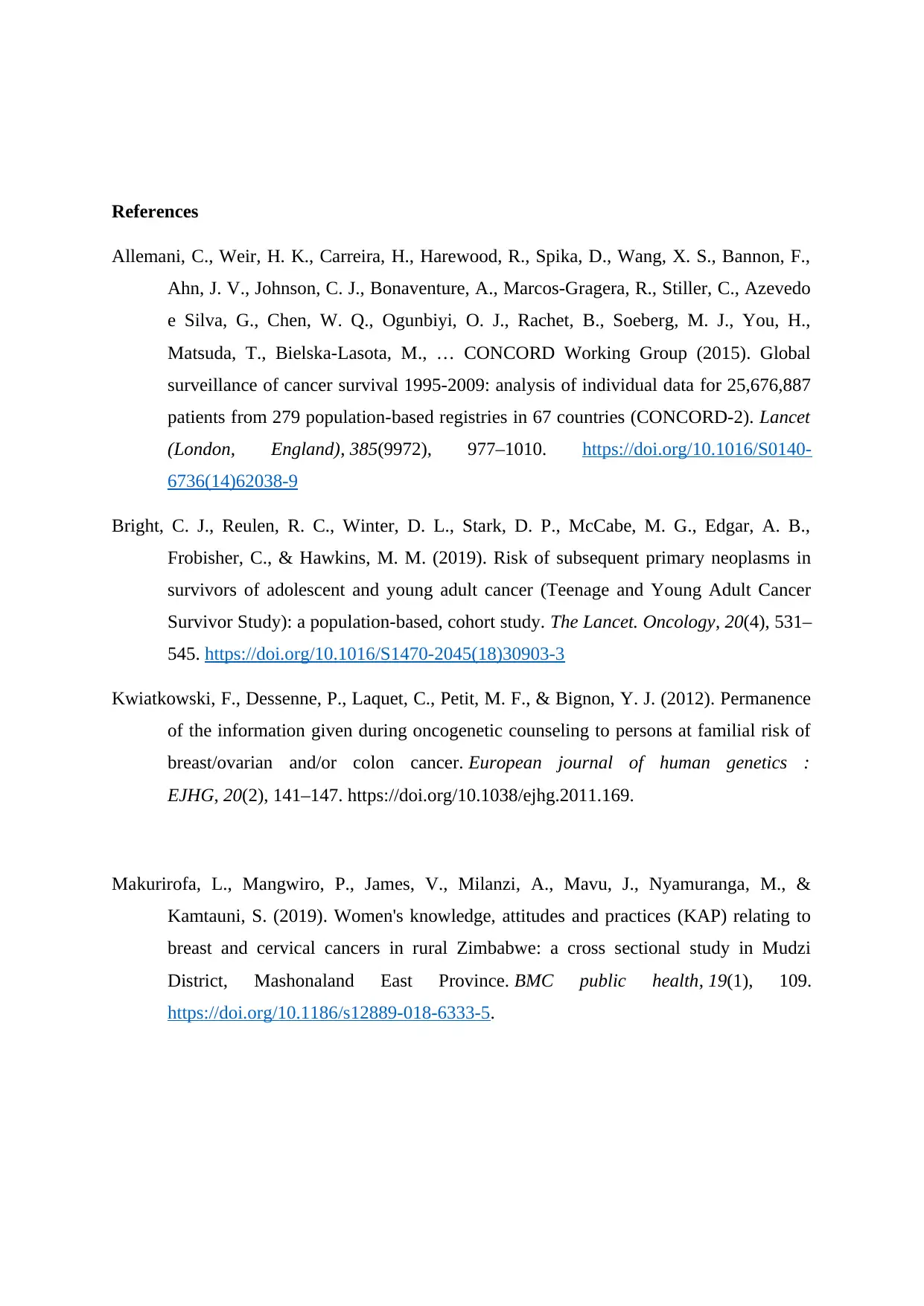Cancer Screening, AI, and Risk Reduction in Public Health Analysis
VerifiedAdded on 2022/08/24
|4
|1129
|14
Report
AI Summary
This report analyzes cancer screening methods, including MRI, CT scans, and mammograms, and their application in middle and low-income countries. It explores the role of artificial intelligence in screening various cancer types and discusses strategies for reducing the risk of prostate, breast, colorectal, and lung cancers. The study references the Behavioral Risk Factor Surveillance System (BRFSS) and relevant variables. The abstract examines subsequent primary neoplasms after adolescent and young adult (AYA) cancer, analyzing data from a study of 200945 participants in Wales and England. The study found significant risks of specific subsequent primary neoplasms, particularly in survivors of breast cancer, cervical cancer, testicular cancer, and lymphoma, highlighting the need for long-term clinical follow-up. The report emphasizes the importance of lung cancer prevention in AYA cancer survivors and provides valuable insights for public health interventions.

Step 1:
1. How cancer is considered as disorder but not deadly?
2. Name few options used to detect and screen cancer specifically in middle and low
income based countries?
3. Describe the role of artificial intelligence in screening various types of cancers?
4. Explain the role of decreasing the risk of prostate/breast/colorectal/lung cancers?
5. Name best suitable strategies associated with cancer screening procedures?
Step 2:
BRFSS refers to Behavioural risk factor surveillance system collects information through
telephonic interviews or by conducting survey that includes usage of standardized
questionnaire, modules and questions (Allemani et.al,2015). Tools such as Random digit
dialling techniques were employed for both cell phones and landlines.
Step 3:
Variables relevant to the study are mentioned below.
STATERE1, CTELENM1,PVTRESD1, COLGSEX, LADULT1, NUMADULT, NUMMEN,
GENHLTH, MENTHLTH, PERSDOC2, HLTHPLN1,CHCSCNCR, CHCOCNCR,
CHCCOPD1, ARTHEXER, LCSFIRST, LCSLAST, LCSNUMCG
Step 4:
MRI,CT Scans, Mammogram, Ultrasound, Imaging, Nuclear medicine and Radiography tests
are considered for the study.
Step 5:
Abstract
Background
Barely any examinations have explored the dangers of ensuing essential neoplasms after
juvenile and youthful grown-up (AYA) disease (Bright et.al,2019). We examined the dangers
of explicit consequent essential neoplasms after every one of 16 kinds of AYA malignant
growth.
1. How cancer is considered as disorder but not deadly?
2. Name few options used to detect and screen cancer specifically in middle and low
income based countries?
3. Describe the role of artificial intelligence in screening various types of cancers?
4. Explain the role of decreasing the risk of prostate/breast/colorectal/lung cancers?
5. Name best suitable strategies associated with cancer screening procedures?
Step 2:
BRFSS refers to Behavioural risk factor surveillance system collects information through
telephonic interviews or by conducting survey that includes usage of standardized
questionnaire, modules and questions (Allemani et.al,2015). Tools such as Random digit
dialling techniques were employed for both cell phones and landlines.
Step 3:
Variables relevant to the study are mentioned below.
STATERE1, CTELENM1,PVTRESD1, COLGSEX, LADULT1, NUMADULT, NUMMEN,
GENHLTH, MENTHLTH, PERSDOC2, HLTHPLN1,CHCSCNCR, CHCOCNCR,
CHCCOPD1, ARTHEXER, LCSFIRST, LCSLAST, LCSNUMCG
Step 4:
MRI,CT Scans, Mammogram, Ultrasound, Imaging, Nuclear medicine and Radiography tests
are considered for the study.
Step 5:
Abstract
Background
Barely any examinations have explored the dangers of ensuing essential neoplasms after
juvenile and youthful grown-up (AYA) disease (Bright et.al,2019). We examined the dangers
of explicit consequent essential neoplasms after every one of 16 kinds of AYA malignant
growth.
Paraphrase This Document
Need a fresh take? Get an instant paraphrase of this document with our AI Paraphraser

\
Methods
The research study conducted with reference to Young and Teenage Adult Cancer study with
regard to survivability is conducted for a total population about 200945 participants for
people aged between 15-40 years in Wales, England from 1970 to 2006. For this study
several organizations such as Welsh and National statistics board associated with cancer
studies were involved to find out the information about growth of malignancy among
individuals. For a total of 16 types the malignancy associated with AYA are considered as
critical studies and this includes different parts present in the body ranges from neck to
bladder (Makurirofa et.al,2019). Here we present outright abundance dangers (;for every
10,000 individual years) for a complete rate of explicit sorts that results in essential
neoplasm for each specific type of AYA malignancy.
Results
For a total 2632456 individuals the entire duration for development (middle follow-up 14·2
years, IQR 7·3–23·1), 11345 resulting essential neoplasms were analysed in 10
3650survivors, most habitually among overcomers of bosom disease, cervical malignant
growth, testicular malignancy, lymphoma associated with Hodgkin. Consequent essential
neoplasms associated with AER’s were close to 13.4 per 10,000s individual with(95% CI
11·4–19·5) malignant growth, 8·2 (3·0–11·4) in overcomers of cervical disease, 11·9 (14·6–
20·1) in overcomers of testicular malignancy, 52·7 (49·4–60·1) with female overcomers of
lymphoma associated with Hodgkin, and 24·8 (22·2–30·4) with reference to male
overcomers of lymphoma associated with Hodgkin. The total rate of all ensuing essential
neoplasms 35 years after analysis was 10·9% (95% CI 10·3–13·6) in overcomers of bosom
malignant growth, 11·8% (13·8–15·7) in overcomers of cervical disease, 20·2% (16·9–19·5)
in overcomers of testicular malignancy, 20·6% (22·4–25·6) in female overcomers of Hodgkin
lymphoma, and 18·5% (14·4–16·0) in male overcomers of Hodgkin lymphoma. In patients
who had made due in any event 20 years from determination of cervical malignancy,
testicular disease, Hodgkin lymphoma in ladies, bosom malignant growth, and Hodgkin
lymphoma in men, we recognized few explicit ensuing essential neoplasms that represent
80%, 51%, 48%, 454%, and 30% of neoplasm abundance rate individually. Diseases
associated with lung are represented by an outstanding extent with regard to neoplasms
present in large numbers with reference to AYA researched.
Methods
The research study conducted with reference to Young and Teenage Adult Cancer study with
regard to survivability is conducted for a total population about 200945 participants for
people aged between 15-40 years in Wales, England from 1970 to 2006. For this study
several organizations such as Welsh and National statistics board associated with cancer
studies were involved to find out the information about growth of malignancy among
individuals. For a total of 16 types the malignancy associated with AYA are considered as
critical studies and this includes different parts present in the body ranges from neck to
bladder (Makurirofa et.al,2019). Here we present outright abundance dangers (;for every
10,000 individual years) for a complete rate of explicit sorts that results in essential
neoplasm for each specific type of AYA malignancy.
Results
For a total 2632456 individuals the entire duration for development (middle follow-up 14·2
years, IQR 7·3–23·1), 11345 resulting essential neoplasms were analysed in 10
3650survivors, most habitually among overcomers of bosom disease, cervical malignant
growth, testicular malignancy, lymphoma associated with Hodgkin. Consequent essential
neoplasms associated with AER’s were close to 13.4 per 10,000s individual with(95% CI
11·4–19·5) malignant growth, 8·2 (3·0–11·4) in overcomers of cervical disease, 11·9 (14·6–
20·1) in overcomers of testicular malignancy, 52·7 (49·4–60·1) with female overcomers of
lymphoma associated with Hodgkin, and 24·8 (22·2–30·4) with reference to male
overcomers of lymphoma associated with Hodgkin. The total rate of all ensuing essential
neoplasms 35 years after analysis was 10·9% (95% CI 10·3–13·6) in overcomers of bosom
malignant growth, 11·8% (13·8–15·7) in overcomers of cervical disease, 20·2% (16·9–19·5)
in overcomers of testicular malignancy, 20·6% (22·4–25·6) in female overcomers of Hodgkin
lymphoma, and 18·5% (14·4–16·0) in male overcomers of Hodgkin lymphoma. In patients
who had made due in any event 20 years from determination of cervical malignancy,
testicular disease, Hodgkin lymphoma in ladies, bosom malignant growth, and Hodgkin
lymphoma in men, we recognized few explicit ensuing essential neoplasms that represent
80%, 51%, 48%, 454%, and 30% of neoplasm abundance rate individually. Diseases
associated with lung are represented by an outstanding extent with regard to neoplasms
present in large numbers with reference to AYA researched.

Discussion
Findings from the study indicated explicit resulting essential neoplasms represent a huge
level of the neoplasms in large numbers with reference to cervical, bosom, testicular
malignant growth, and Hodgkin lymphoma gives a proof base to educate needs for clinical
long haul development (Kwiatkowski et.al,2012). Conspicuousness of lung malignancy for
every AYA tumours shows need for additional work planned for forestalling and
diminishing the weight of this disease in future overcomers of AYA malignancy.
Findings from the study indicated explicit resulting essential neoplasms represent a huge
level of the neoplasms in large numbers with reference to cervical, bosom, testicular
malignant growth, and Hodgkin lymphoma gives a proof base to educate needs for clinical
long haul development (Kwiatkowski et.al,2012). Conspicuousness of lung malignancy for
every AYA tumours shows need for additional work planned for forestalling and
diminishing the weight of this disease in future overcomers of AYA malignancy.
⊘ This is a preview!⊘
Do you want full access?
Subscribe today to unlock all pages.

Trusted by 1+ million students worldwide

References
Allemani, C., Weir, H. K., Carreira, H., Harewood, R., Spika, D., Wang, X. S., Bannon, F.,
Ahn, J. V., Johnson, C. J., Bonaventure, A., Marcos-Gragera, R., Stiller, C., Azevedo
e Silva, G., Chen, W. Q., Ogunbiyi, O. J., Rachet, B., Soeberg, M. J., You, H.,
Matsuda, T., Bielska-Lasota, M., … CONCORD Working Group (2015). Global
surveillance of cancer survival 1995-2009: analysis of individual data for 25,676,887
patients from 279 population-based registries in 67 countries (CONCORD-2). Lancet
(London, England), 385(9972), 977–1010. https://doi.org/10.1016/S0140-
6736(14)62038-9
Bright, C. J., Reulen, R. C., Winter, D. L., Stark, D. P., McCabe, M. G., Edgar, A. B.,
Frobisher, C., & Hawkins, M. M. (2019). Risk of subsequent primary neoplasms in
survivors of adolescent and young adult cancer (Teenage and Young Adult Cancer
Survivor Study): a population-based, cohort study. The Lancet. Oncology, 20(4), 531–
545. https://doi.org/10.1016/S1470-2045(18)30903-3
Kwiatkowski, F., Dessenne, P., Laquet, C., Petit, M. F., & Bignon, Y. J. (2012). Permanence
of the information given during oncogenetic counseling to persons at familial risk of
breast/ovarian and/or colon cancer. European journal of human genetics :
EJHG, 20(2), 141–147. https://doi.org/10.1038/ejhg.2011.169.
Makurirofa, L., Mangwiro, P., James, V., Milanzi, A., Mavu, J., Nyamuranga, M., &
Kamtauni, S. (2019). Women's knowledge, attitudes and practices (KAP) relating to
breast and cervical cancers in rural Zimbabwe: a cross sectional study in Mudzi
District, Mashonaland East Province. BMC public health, 19(1), 109.
https://doi.org/10.1186/s12889-018-6333-5.
Allemani, C., Weir, H. K., Carreira, H., Harewood, R., Spika, D., Wang, X. S., Bannon, F.,
Ahn, J. V., Johnson, C. J., Bonaventure, A., Marcos-Gragera, R., Stiller, C., Azevedo
e Silva, G., Chen, W. Q., Ogunbiyi, O. J., Rachet, B., Soeberg, M. J., You, H.,
Matsuda, T., Bielska-Lasota, M., … CONCORD Working Group (2015). Global
surveillance of cancer survival 1995-2009: analysis of individual data for 25,676,887
patients from 279 population-based registries in 67 countries (CONCORD-2). Lancet
(London, England), 385(9972), 977–1010. https://doi.org/10.1016/S0140-
6736(14)62038-9
Bright, C. J., Reulen, R. C., Winter, D. L., Stark, D. P., McCabe, M. G., Edgar, A. B.,
Frobisher, C., & Hawkins, M. M. (2019). Risk of subsequent primary neoplasms in
survivors of adolescent and young adult cancer (Teenage and Young Adult Cancer
Survivor Study): a population-based, cohort study. The Lancet. Oncology, 20(4), 531–
545. https://doi.org/10.1016/S1470-2045(18)30903-3
Kwiatkowski, F., Dessenne, P., Laquet, C., Petit, M. F., & Bignon, Y. J. (2012). Permanence
of the information given during oncogenetic counseling to persons at familial risk of
breast/ovarian and/or colon cancer. European journal of human genetics :
EJHG, 20(2), 141–147. https://doi.org/10.1038/ejhg.2011.169.
Makurirofa, L., Mangwiro, P., James, V., Milanzi, A., Mavu, J., Nyamuranga, M., &
Kamtauni, S. (2019). Women's knowledge, attitudes and practices (KAP) relating to
breast and cervical cancers in rural Zimbabwe: a cross sectional study in Mudzi
District, Mashonaland East Province. BMC public health, 19(1), 109.
https://doi.org/10.1186/s12889-018-6333-5.
1 out of 4
Your All-in-One AI-Powered Toolkit for Academic Success.
+13062052269
info@desklib.com
Available 24*7 on WhatsApp / Email
![[object Object]](/_next/static/media/star-bottom.7253800d.svg)
Unlock your academic potential
Copyright © 2020–2025 A2Z Services. All Rights Reserved. Developed and managed by ZUCOL.